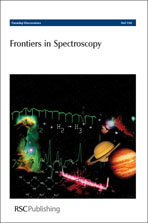Charge-transfer and the hydrogen bond: Spectroscopic and structural implications from electronic structure calculations
Abstract
The absolutely localized molecular orbital (ALMO) model is a fully variational approach which permits polarization of molecules interacting in a cluster while prohibiting charge-transfer (or dative interactions) between individual molecules. The ALMO model can be applied within any density functional theory calculation – the B3LYP functional is employed in this work. ALMO DFT calculations of observables such as optimized geometry, vibrational frequencies and their intensities, and vertical detachment energies are performed for the water dimer, the chloride–water complex and the
- This article is part of the themed collection: Frontiers in Spectroscopy

 Please wait while we load your content...
Please wait while we load your content...